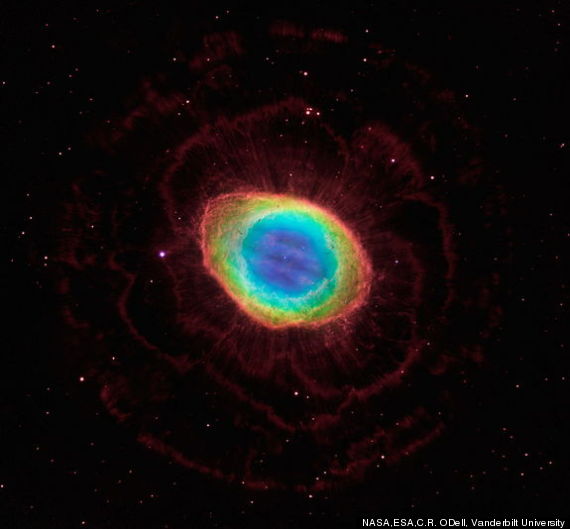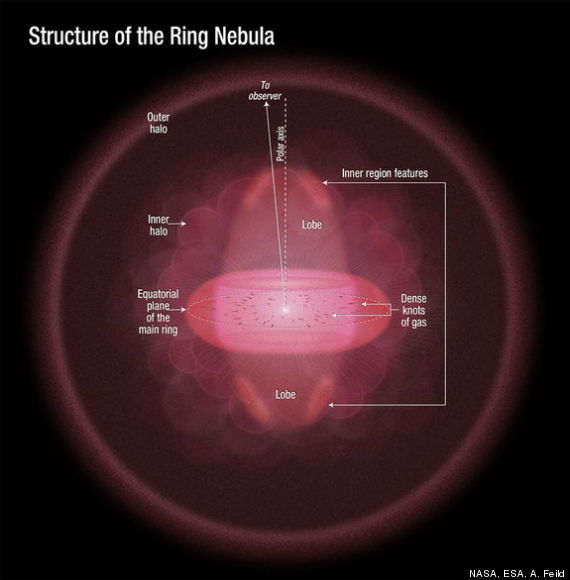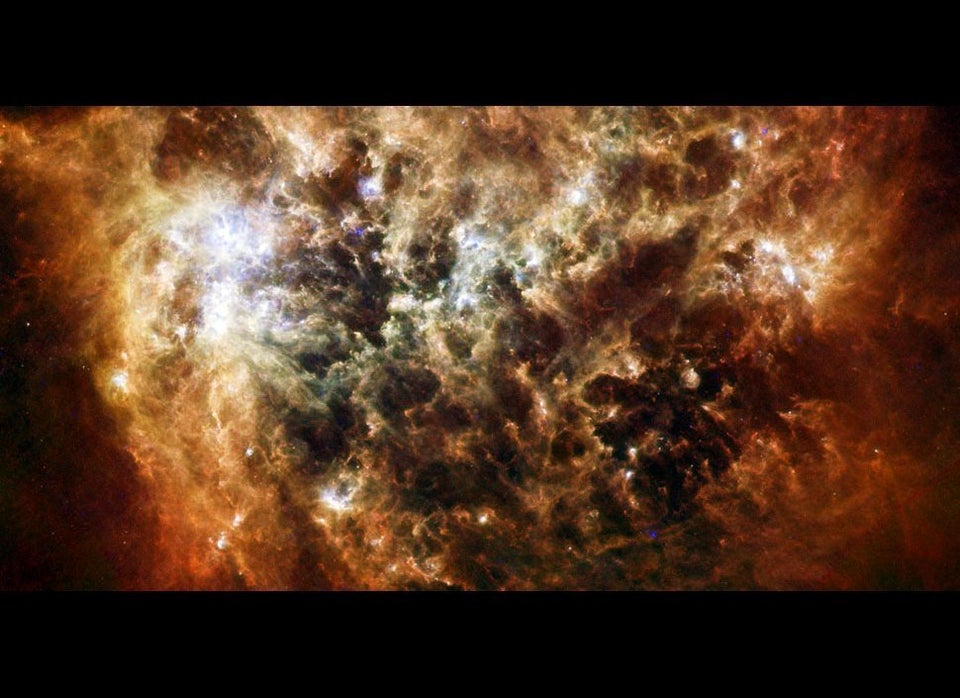By: Tariq Malik
Published: 05/23/2013 05:10 PM EDT on SPACE.com
The iconic Ring Nebula may seem like just a stunning circle of wispy interstellar gas, but new images from the Hubble Space Telescope reveal it to be more like a deep-space jelly doughnut, scientists say.
The new Hubble telescope images have allowed astronomers to take their most detailed look at the Ring Nebula than ever before, revealing an unprecedented view of the nebula's three-dimensional structure.
"The nebula is not like a bagel, but rather, it's like a jelly doughnut, because it's filled with material in the middle," study leader C. Robert O'Dell, an astronomer with Vanderbilt University in Nashville, Tenn., said in a statement today (May 23).
 In this composite image, visible-light observations by NASA's Hubble Space Telescope are combined with infrared data from the ground-based Large Binocular Telescope in Arizona to assemble a dramatic view of the well-known Ring Nebula. Called a planetary nebula, the Ring Nebula is the glowing remains of a Sun-like star.
In this composite image, visible-light observations by NASA's Hubble Space Telescope are combined with infrared data from the ground-based Large Binocular Telescope in Arizona to assemble a dramatic view of the well-known Ring Nebula. Called a planetary nebula, the Ring Nebula is the glowing remains of a Sun-like star.
In addition to seeing the new images, astronomers were able to create a video of the Ring Nebula's structure with the Hubble telescope data.
The Ring Nebula is just over 2,000 light-years from Earth in the Lyra constellation and is 1 light-year (about 6 trillion miles, or 10 trillion kilometers) wide. The nebula formed 4,000 years ago when a dying star several times the mass of our sun ran out of its nuclear fuel.
The star then swelled in size to become an immense red giant, and then began shedding its outer layers of gas as it collapsed in on itself to become a white dwarf. Intense ultraviolet light from the star heats up the surrounding gas to make it glow, Hubble researchers explained.
Today, the Ring Nebula is a popular stargazing target for amateur astronomers, because its ring-like shape is face-on to Earth, making it an easily identifiable object when viewed through telescopes. But the new Hubble Space Telescope observations show that the Ring Nebula is not a perfect ring at all.
 This illustration depicts a sideways view of the Ring Nebula, as deduced by astronomers using new Hubble observations. The doughnut-shaped feature in the center of the graphic is the main ring. The lobes above and below the ring comprise a football-shaped structure that pierces the ring. Dense knots of gas are embedded along the ring's inner rim.
This illustration depicts a sideways view of the Ring Nebula, as deduced by astronomers using new Hubble observations. The doughnut-shaped feature in the center of the graphic is the main ring. The lobes above and below the ring comprise a football-shaped structure that pierces the ring. Dense knots of gas are embedded along the ring's inner rim.
Hubble's powerful Wide Field Camera 3 revealed a complicated 3D structure that permeates, and at times extends out from, the primary nebula mass. Scientists combined the images with ground-based observations and found the prominent ring-like structure of the nebula appears to wrap around a blue-hued feature shaped like a football, with the ends of the "football" jutting out from the ring's border.
O'Dell's team was surprised to find irregular knots of dark, dense gas along the inner ring of the nebula like spokes in a wheel, NASA officials said.
"These gaseous tentacles formed when expanding hot gas pushed into cool gas ejected previously by the doomed star," Hubble officials explained in an image description. "The knots are more resistant to erosion by the wave of ultraviolet light unleashed by the star."
The Ring Nebula is expanding outward at the breakneck pace of 43,000 mph (69,200 km/h) and will continue to do so for the next 10,000 years, scientists said. By studying the nebula, researchers hope to learn more about how Earth's sun, which is a middle-age star, will die in 6 billion years.
"When the sun becomes a white dwarf, it will heat more slowly after it ejects its outer gaseous layers," O'Dell said. "The material will be farther away once it becomes hot enough to illuminate the gas. This larger distance means the sun's nebula will be fainter because it is more extended."
Email Tariq Malik at tmalik@space.com or follow him @tariqjmalik and Google+. Follow us @Spacedotcom, Facebook and Google+. Original article on SPACE.com.
Copyright 2013 SPACE.com, a TechMediaNetwork company. All rights reserved. This material may not be published, broadcast, rewritten or redistributed.
Our 2024 Coverage Needs You
It's Another Trump-Biden Showdown — And We Need Your Help
The Future Of Democracy Is At Stake
Our 2024 Coverage Needs You
Your Loyalty Means The World To Us
As Americans head to the polls in 2024, the very future of our country is at stake. At HuffPost, we believe that a free press is critical to creating well-informed voters. That's why our journalism is free for everyone, even though other newsrooms retreat behind expensive paywalls.
Our journalists will continue to cover the twists and turns during this historic presidential election. With your help, we'll bring you hard-hitting investigations, well-researched analysis and timely takes you can't find elsewhere. Reporting in this current political climate is a responsibility we do not take lightly, and we thank you for your support.
Contribute as little as $2 to keep our news free for all.
Can't afford to donate? Support HuffPost by creating a free account and log in while you read.
The 2024 election is heating up, and women's rights, health care, voting rights, and the very future of democracy are all at stake. Donald Trump will face Joe Biden in the most consequential vote of our time. And HuffPost will be there, covering every twist and turn. America's future hangs in the balance. Would you consider contributing to support our journalism and keep it free for all during this critical season?
HuffPost believes news should be accessible to everyone, regardless of their ability to pay for it. We rely on readers like you to help fund our work. Any contribution you can make — even as little as $2 — goes directly toward supporting the impactful journalism that we will continue to produce this year. Thank you for being part of our story.
Can't afford to donate? Support HuffPost by creating a free account and log in while you read.
It's official: Donald Trump will face Joe Biden this fall in the presidential election. As we face the most consequential presidential election of our time, HuffPost is committed to bringing you up-to-date, accurate news about the 2024 race. While other outlets have retreated behind paywalls, you can trust our news will stay free.
But we can't do it without your help. Reader funding is one of the key ways we support our newsroom. Would you consider making a donation to help fund our news during this critical time? Your contributions are vital to supporting a free press.
Contribute as little as $2 to keep our journalism free and accessible to all.
Can't afford to donate? Support HuffPost by creating a free account and log in while you read.
As Americans head to the polls in 2024, the very future of our country is at stake. At HuffPost, we believe that a free press is critical to creating well-informed voters. That's why our journalism is free for everyone, even though other newsrooms retreat behind expensive paywalls.
Our journalists will continue to cover the twists and turns during this historic presidential election. With your help, we'll bring you hard-hitting investigations, well-researched analysis and timely takes you can't find elsewhere. Reporting in this current political climate is a responsibility we do not take lightly, and we thank you for your support.
Contribute as little as $2 to keep our news free for all.
Can't afford to donate? Support HuffPost by creating a free account and log in while you read.
Dear HuffPost Reader
Thank you for your past contribution to HuffPost. We are sincerely grateful for readers like you who help us ensure that we can keep our journalism free for everyone.
The stakes are high this year, and our 2024 coverage could use continued support. Would you consider becoming a regular HuffPost contributor?
Dear HuffPost Reader
Thank you for your past contribution to HuffPost. We are sincerely grateful for readers like you who help us ensure that we can keep our journalism free for everyone.
The stakes are high this year, and our 2024 coverage could use continued support. If circumstances have changed since you last contributed, we hope you'll consider contributing to HuffPost once more.
Already contributed? Log in to hide these messages.

 In this composite image, visible-light observations by NASA's Hubble Space Telescope are combined with infrared data from the ground-based Large Binocular Telescope in Arizona to assemble a dramatic view of the well-known Ring Nebula. Called a planetary nebula, the Ring Nebula is the glowing remains of a Sun-like star.
In this composite image, visible-light observations by NASA's Hubble Space Telescope are combined with infrared data from the ground-based Large Binocular Telescope in Arizona to assemble a dramatic view of the well-known Ring Nebula. Called a planetary nebula, the Ring Nebula is the glowing remains of a Sun-like star. This illustration depicts a sideways view of the Ring Nebula, as deduced by astronomers using new Hubble observations. The doughnut-shaped feature in the center of the graphic is the main ring. The lobes above and below the ring comprise a football-shaped structure that pierces the ring. Dense knots of gas are embedded along the ring's inner rim.
This illustration depicts a sideways view of the Ring Nebula, as deduced by astronomers using new Hubble observations. The doughnut-shaped feature in the center of the graphic is the main ring. The lobes above and below the ring comprise a football-shaped structure that pierces the ring. Dense knots of gas are embedded along the ring's inner rim.